OISTAT - SCENOGRAPHY COMMISSION
1999 Scenography Commission Meeting
Held at 'The Dark Night', Antwerp, Belgium
|
| The minutes of meetings held at 10.00-13.00 Friday 1 October, 10.00-13.17 and 19.17-20.44 Saturday 2 October and 10.00-12.00 Sunday 3 October 1999 have been combined and renumbered for clarity. |
Present :
Belgium - Jerôme Maeckelbergh
Chile - Ruby Goldstein
Czech Republic - Simona Rybakova *
Estonia - Kustav-Agu Puuman
France - Etienne Bisson
Germany - Harald Reichelt
Great Britain - Peter Ruthven Hall
Israel - Tali Itzhaki
Japan - Kazue Hatano
Korea - In-Suk Suh (Chair)
Netherlands - Peter De Kimpe
Netherlands - Louis Janssen (Executive
Committee)
Philippines - Rolando Meriales de Leon
Slovak Republic - Ales Votava
Sweden - Sunniva Thelestam
USA - Laura Crow (ex officio Chair, CDWG *)
USA - Richard Thomas
Yugoslavia - Miodrag Tabacki |
In Attendance
Belgium - Rita Geerts *
Czech Republic - Simon Caban
Israel - Avi Oz
Japan - Chika Kato
Japan - Terumitsu Takahashi
Korea - Na Rae Hong
Netherlands - Rien Bekkers *
Sweden - Punilla Bodin *
USA - Elbin Cleveland
USA - Marianne Custer *
USA - Margaret Mitchell *
Yugoslavia - Angelina Atlagic * |
Apologies
Austria - Florian Kradolfer
Brazil - Jose Carlos Serroni
Bulgaria - Marina Raytchinova
Canada - Robert Doyle
Canada - Ron Fedoruk
Canada - Alison Green *
Canada - Kathleen Irwin
Canada (Quebec) - Jacques Lemieux
Canada (Quebec) - Claude Sabourin
Cuba - Jose Antonio Prades Hung
Finland - Timo Martinkauppi
Finland - Maija Pekkanen
Great Britain - Pamela Howard
Great Britain - Richard Hudson
Hong Kong - Chun-yin Ip
Hong Kong - Rosie Lam Tung
Hungary - Erzsebet Ek
Israel - Meira Sheffy
Italy - Fransesco Sforza
Mexico - Rene Duron
Mexico - Eugenio Servin *
Mexico - Luis Fernando Payan
New Zealand - Tolis Papazoglou
Nigeria - Dr. James Olusola Aborisade
Philippines - Rosauro Q. de la Cruz
Philippines - Alan Y. Flores
Poland - Ewa Kakczak-Koziek
Poland - Piotr Orbacaj
South Africa - M Michael
USA - Richard Durst
USA - Ralph Funicello
USA - Sarah Nash Gates *
USA -Susan Tsu *
*Members of the Costume Design Working Group |
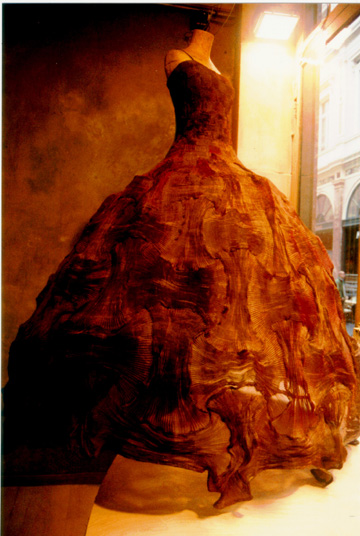
This is a fashion gown on sale in Brussels inspired by Issey Miyake |

Photo 1. Meeting in Antwerp
in the "Dark Night" the home of Jerome Maeckelbergh
|
1. Welcome from the Chair, Mr. In-Suk Suh
In-Suk Suh welcomed Scenography Commission members to the 1999 meeting hosted by Jerôme Maeckelbergh at his home in Antwerp on behalf of the Belgium Association for Scenographers and Theatre Technicians. In-Suk Suh expressed his gratitude to Jerôme Maeckelbergh for hosting a second OISTAT meeting this year and for his enlightened approach to arranging the meeting whilst keeping the cost manageable. In-Suk Suh emphasized the importance of meeting regularly in person and also of relaying information and findings back to all members of the OISTAT Centers worldwide. Whilst each Commissioner must fulfil this responsibility it is hoped that the Scenography Commission pages on the OISTAT Website will reach an ever-increasing audience. He then read out his address posted on the Scenography Commission Home Page of the OISTAT Website.
2. Minutes of the 1998 Meeting of the Scenography Commission
The minutes of this meeting are posted on the Website but insufficient delegates had read them for them to be approved. Comments should be made to the Chair for corrections.
3. Report on 1998 Scenography Commission Meeting in Israel
The Symposium considered whether there was ëNationalism in Scenographyí. The papers presented were gratefully received. The meeting, which included an exhibition, a number of visits and much discussion was considered to be very successful. Tali Itzhaki thanked everyone for their contribution to the Haifa Symposium. At In-Suk Suh's request, she will try to disseminate the proceedings of the symposium to the Scenography Commission members. Peter de Kimpe recommended that the host country announce the symposium topic sufficiently far in advance to allow members to submit papers in advance. There followed a formal Vote of Thanks to Ben-Zion Munitz, Avi Oz, Tali Itzhaki and the Association of Israeli Theatre Designers in appreciation of organizing such a successful meeting.
4. Report on ìScenographerís Forum PQí99î
100 delegates had met in Prague to consider the topic: ëWorking together in the 21st Centuryí. Many delegates contributed to the discussion, which agreed the need:
- To uphold the 30-year tradition of OISTAT
- To spread membership to non-member nations including Brazil, South Africa, Uruguay and other countries in South America and Asia.
- To maintain strong activity in the Commission and to initiate related Design Working Groups:Sound Design (Florian Kradolfer and Richard Thomas); Lighting Design (Jennifer Tipton); Multimedia and Digital Design (Laurie Shawn Borshoboy)
- To send a booklet of greetings to former Chairman, John Bury, who was unable to attend owing to ill health. Members talked and felt in common service with the many great scenographers present including Ming Cho Lee and Ralph Koltai as well as those that had managed to attend in the face of national or personal adversity.
5. Report on 1999 OISTAT Executive Committee Meeting
Louis Janssen, a member of the Executive Committee, one of Vice President of OISTAT reported from the OISTAT Executive:
- The Dutch Government has suggested it may withdraw its subsidy ($50,000) at the end of 2000.
- There was a real risk of no further funding from 2001 and no formal plans had yet been made on the future of the General Secretariat.
- The next Executive Committee meeting will be held in Estonia in November 1999.
- John Faulkner (Great Britain) has become Chair of the Publications Commission, Bob Logger (Netherlands) Chair of the History and Theory Commission.
6. Annual Plan for the Scenography Commission
In announcing his annual plan In-Suk Suh made the following proposal:
- To expand membership to include Brazil, South Africa and Asia in the near future.
- To collaborate work between the commissions.
- To set up new Working Groups for Sound Design, Lighting Design, Television and Film, Special Effects and Multimedia in addition to Costume Design;
- The importance of there being an administrative secretary to the Scenography Commission;
- Regular check out of our web site of OISTAT, Scenography Commission is recommended.
- The need to raise funds from any appropriate source to maintain the activities of the Commission.
- To keep in good touch with the members by E-mail.
- To solve the copyright problem for the web pages.
7. Structure of Scenography Commission Operations
Vice Chair, Florian Kradolfer, submitted, by proxy, the existing mission statement for the Commission. It was agreed that:
- ëOISTAT Centerí is used in preference to ëNational OISTAT Centerí as this might create confusion in certain instances; it is the term used in the OISTAT statutes and should be adopted here;
- ëWorking Groupí is the appropriate name for all ësub-committeesí
- ëChairí is preferred to ëChairmaní or ëChairpersoní
- 'Live performanceí is used in preference to ëtheatre designí
- Exhibitions of work and interaction with students are important parts of any agenda
- Some grammar and descriptions require clarification; Peter Ruthven Hall was asked to work on these.
An amended copy of the mission statement is enclosed with these minutes.
|
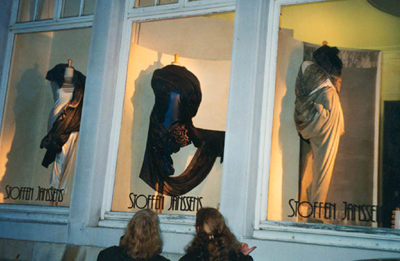
Fabric Shop (click to enlarge)
|
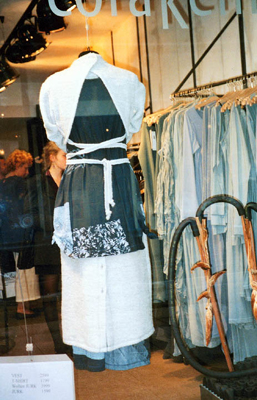
Knit Wear for sale (click to enlarge)
|
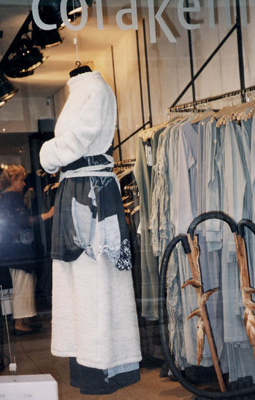
Knit Wear for sale (click to enlarge)
|
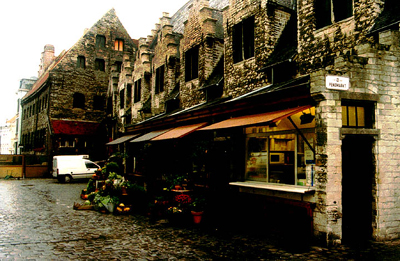
Ghent Flower Shop (click to enlarge)
|
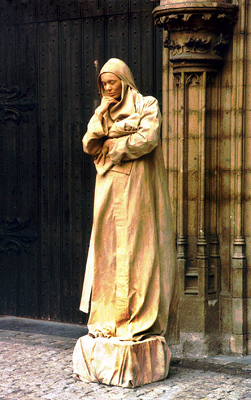
Street Theatre - Madonna and Child (click to enlarge)
|
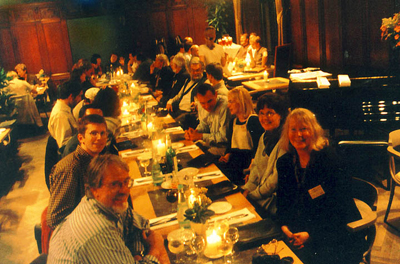
Dinner Theatre (click to enlarge) |
8. Policy on Working Groups
It was agreed that the Chairs of working Groups become ex officio members of the Commission with a right to represent the Working Group at meetings, but with no vote. There was concern that Working Groups would in some way destroy the integrity of the Scenography Commission. This had never been intended. Louis Janssen emphasized the importance of continuing work between meetings to maintain activity; Working Groups are an excellent way to achieve this. A Working Group can consider a project or an area of work in greater detail than is possible at the annual meetings. It can draw on invaluable expertise and contributions from a wider specialist membership. At Peter de Kimpeís recommendation, the Scenography Commission will receive reports and can vote, if necessary, to ratify the agenda or schedule of Working groups at the annual meetings. He reminded the group that the Working Groups can meet separately, but it is the responsibility of the Chair of the Working Group to report back to the Scenography Commission. And In Suk Suh has distributed the letter of one of Vice presidents, Maija Pekannen to all the Delegates before the meeting for the General discussion. |
General Discussion 1
- Jerôme Maeckelbergh pointed out that it was a misconception that we intended to split up the group. Working Groups would support the main program of the Commission. They actually benefit entire commission not just the Working Group.
- We canít separate out disciplines as we all work together on the stage (Kustav-Agu Puuman). Sometimes designers work across disciplines so lighting, set and costume design need to be integrated (Meira Sheffy). It is important not to further divide out disciplines as we have done between Scenography and Architecture (Piotr Obracaj).
- Whilst there may be a focus on a particular Working Group at any Commission meeting we should expect update reports from each Working Group. Members of the Working Group may attend and meet but only their Chair should make presentations on their behalf.
- Additional self-funded delegates make an important contribution to meetings but should not normally be invited to speak in order to avoid prolonged discussions (Peter de Kimpe)
- Working Groups should set an agenda which will help to mark greater achievement in the long run (Robert Doyle).
- We must involve Italian Designers in future meetings in the hope that an Italian OISTAT Center could be formed. Fransesco Sforza had hoped to attend the meeting and was optimistic about attending in the future (Peter de Kimpe).
9. Presentation of Special Design Working Groups
9.1 Costume Design Working Group (CDWG)
Laura Crow was accepted by the Costume Design Working Group as the ëconsensus choiceí of Chair until a full election could take place at the next Scenography commission Meeting in 2000. It was agreed that the CDWG could elect the Chair from within its membership by its own rules.
As an ex officio (non-voting) member of the Scenography Commission, Laura presented a report following several independent meetings of the CDWG held in Antwerp. Sarah Nash Gates had initiated the Costume Design Working Group at the meeting in Helsinki in 1996. 40 delegates had attended a successful meeting of the CDWG in Las Vegas 1994 and the group had also contributed to the side program at PQí99. Sarah regrettably had to stand down as the CDWG Chair. She sent her greetings to the Commission. Sarah Nash Gates had compiled comments and suggestions from members of the CDWG and these were then presented with additional remarks from those present in Antwerp. |
Meetings
The CDWG needs to meet regularly and at the same time and place as the Scenography Commission meetings when members are also together. Other self-funded meetings would also be possible at other times. Communication: Internet The CDWG would begin to amass information that already exists and combine into one Web site under OISTAT; this is effectively an assimilation of websites. The website would be bi-lingual in the official language (English) and language of contributing nation. Material might include video footage, imagery, text and databases. Communication: other means It may not be feasible or cost-effective to provide a printed alternative to data on the Web site although it is recognized that there is still limited access to the Website in some countries. Database of Costume Designers A list of contacts details for costume designers in each country cross-referenced by experience (opera/theatre/dance/devised productions/teaching/languages etc.). A consistent format would be sought to that of the Scenography Commission Website. Images of work would be beneficial if designers can be persuaded to waive copyright. These could be searchable by designer, writer, theatre, country etc. Career history would also be valuable for research. Research Databases Details of museum collections and galleries, cultural and ethnographic information.
Contact details for historical costume societies, period patterns;
Bibliographies of research and publications; bookstores;
Suppliers of fabrics, accessories, clothing, markets and hire firms;
ëTalentí - e.g. mask makers, crafts people, costume supervisors, workshops, and puppet makers. Education and Training Details of courses and training options available. Events Details of exhibitions, graduate exhibitions, conferences. Chat Room This will provide a forum for general and specific discussion. Who is doing new and interesting work, sharing ideas, job notice board, bulletin board for posting for questions. Links to complimentary sites Details of the work of other relevant organizations, by ëhotlinksí. In addition to contributions provided by those attending the following offered points for consideration: Jan Bee Brown, Laura Crow, Kyoko Domoto, Robert Doyle, Ralph Funicello, Sarah Nash Gates, Pamela Howard, Chun-yin Ip, Jerôme Maeckelbergh, Luis Fernando Payan, Maija Pekkanen, Fransesco Sforza, Meira Sheffy and Suzan Tsu. A discussion followed the report concluding the following key points:
- Louis Janssen suggested that the Scenography Commission could use the OISTAT web page for the CDWG. Web site materials should flow through Laura Crow to Gustaf Kull.
- In-Suk Suh must authorize the creation of the Costume Design Working Group Web Page with the Secretary General.
- Laura Crow offered to co-ordinate this initial effort during Summer 2000. It is imperative that each OISTAT Center begins to compile information to pass on to Laura as soon as possible - see Action Box.
- Funding would be required to expand and fulfil the intentions of the CDWG. All suggestions for sources will be welcomed.
- Imagery submitted on the website is difficult to protect from unlawful copying. A copyright key could be introduced to prevent ëdown-loadingí of imagery without the copyright clause appearing on screen. Low-grade scans that look good on screen but are inferior when downloaded may also deter plagiarists!
- OISTAT Centers intending to set up a new website could do so from a new template provided by the ëWebmasterí to ensure consistency of databases. Jerôme Maeckelbergh demonstrated an option for compiling a consistent style database of members that we could implement worldwide.
- Information should be sought from all suitable sources; for instance, Ales Votava suggested seeking permission from the Theatre Institute in Slovakia to share their information. Other resources should also be approached
Future Program
In addition to regular meetings alongside Scenography Commission meetings the CDWG was optimistic about arranging or participating in the following:
March 2000 - Potential for informal meeting in Antwerp at non-OISTAT Costume Design Symposium March 2001 - Proposed meeting in Long Beach, California as part of the USITT convention (subject to confirmation). The aim would be to bring costume designers together to ëShare Secretsí.
June 2003 - Workshops and side program at PQ Action: All Scenography Commission members are instructed to provide Laura Crow with details of costume resources available from their OISTAT Center. This should include:
1. Contact name, address, e-mail, fax etc. for a key contact in each OISTAT Center
2. Details of all information relating to costume design (and website address) on each OISTAT Center Website
3. Details of all information relating to costume design published (in print) by each OISTAT Center.
4. All other relevant information (Internet and print) relating to costume collections, archives, museums, publications etc.
9.2 Lighting and Sound Design Working Group (L+SDWG)
In-Suk Suh reported that Austria had agreed to focus the Austrian Scenography Commission Meetings on the topic ëLighting and Soundí. Austria will host three or four designers (including expenses), perhaps one from each continent. Hopefully, individual OISTAT Centers will provide additional support for sound and lighting delegates to help organize the inaugural meeting of the Lighting and Sound Working Group. He hoped that the Scenography Commission would support the plan to focus the topics for the next four years via the newly formed Working Groups and then re-evaluate the plan after four years. Florian Kradolferís fuller proposal is given under item 11.
9.3 Set Design Working Group (SDWG)
The proposal for developing the SDWG was based on that for the CDWG. The following points were considered:
- Jerôme Maekelbergh will work to start a designer's website but prefers not to become a ëone person working groupí.
- Common sense should be used in limiting the size and scope of submittals to OISTAT web pages. Peter de Kimpe suggested that the Scenography Commission establish guidelines for designersí biographies and use the format adapted in the web site of the Society of British Theatres Designers. These bios. can be viewed at: http://www.theatredesign.org.uk
- Each OISTAT Center must secure copyright clearance for material they submit to the web pages. Jerôme Maekelbergh also suggested that the web page include a link or notice regarding copyright.
10. Exchange of ideas about PQ 2003
Simona Rybakova explained the organization of the Prague Quadrennial and asked the Scenography Commission to make suggestions for improvements. It was important to focus opinion through the Scenography Commission and there was approximately one year in which comments could be made. The following points were considered:
- Miodrag Tabacki commended the organizers of the PQ and the OISTAT side programs for the overall excellence in presentation and organization. It was important to increase educational and other opportunities in the side program of PQ.
- The importance of celebrating the work of an important artist Josef Svoboda in 1995, Ralph Koltai in 1999 and the Homage to Scenography in 1999.
- Should PQ include more directors?
- Should PQ include a competition? Simona Rybakova suggested that she could investigate the possibility of PQ hosting a pavilion which would not follow competition rules, e.g. every section together, which would allow freedom to decide to be out of the competition (like Holland this year).
- Should the rules of the competition change to allow multiple countries to co-organize an exhibit? Peter de Kimpe suggested that this might make it difficult for PQ judges to award a prize to an individual country.
- General concern was expressed that the rules of the competition are not published and criteria for judging not established and available. There was also disagreement as to whether there should be written guidelines.
- Should individual countries be allowed to decide whether to combine their student and national exhibitions? This would allow some countries to design a better exhibit, more fully explore their national culture in their exhibits and provide simpler and more effective and less expensive security. Would a country be able to get more money for the exhibition if the exhibits were combined (some felt that this was not necessarily true)? On the other hand, professors might prefer to see all student work exhibited together, students might enjoy exhibiting together and thematic exhibitions might make it difficult to include student exhibitions.
- Some expressed concern that combining exhibits might yield a single pavilion devoted to the exhibitions of one or a couple of countries. Members seemed to agree that architecture and theatre performances were very different and should not be exhibited together with national or student exhibitions and that this was a difficult issue to resolve without the involvement of architects and students.
- How can security be improved at the exhibitions? There were many problems at the exhibition with security such as a stolen computer, slides, etc. Perhaps a security system could be created which used a number of paid guards who supervised a larger number of student security personnel. Kazue Hatano suggested that PQ might work better if the cash prizes were used to provide better security.
- Should PQ encourage and allow more performances? Could live performance be added to the thematic section? What would happen when 50 performances occurred at once? Should performances be scheduled throughout the festival rather than over the initial period?
- Is there a better way to isolate sound from one exhibit to another? Should PQ adopt rules, which prevent one exhibit from audibly interfering with another?
- Should PQ be shortened to 10 days? Might encouraging the public to attend in the first days of the exhibitions prove to be a little too chaotic? Would this adversely affect the financial feasibility of the exhibition due to smaller attendance? Kazue Hatano reported hearing that the people of the Czech Republic might feel that a longer period is better for them.
- Should the Thematic Section stay or be eliminated?
- Should PQ award a student prize? It is unsure there will be a UNESCO Prize next time. Simona Rybakova reminded the group that this question had already been decided in Helsinki.
- Is it possible to have copyright agreements included in paperwork given to participating countries? In order to avoid breach of copyright each exhibitor would need to grant license for their work to be used for certain promotional material; e.g. print, Website, advertisements, educational materials and general publicity (Jerôme Maeckelbergh).
- To improve promotion and publicity of PQ and OISTAT activities as widely as possible, the documentary on PQí99 could be used to promote PQ to potential sponsors and attendees (In-Suk Suh) that it would soon be available from the Theatre Institute in Prague. Jerôme Maeckelbergh suggested that the recording had focused on official events rather than on artistic activities but Simona said that a young director filmed an extra 40 hours of material on activities that would also be included. In-Suk Suh was keen to gain access to footage for promotional activities and to show potential sponsors. It was important for them to confer with their OISTAT Centers before voting officially. The group agreed to hold a vote of ëfeelingsí and then confirm that vote with their OISTAT Centers.
- If the OISTAT Center desired to change their vote, they should send those changes to In-Suk Suh and Simona Rybakova. The three votes of feeling were as follows: Note: only those members who voted to abstain were counted in the ëabstainí category.
Vote 1
Should students be rewarded with a non-cash prize?
9 Agree
2 Disagree
2 Abstain
Passed (GB chooses to agree) |
Vote 2
It must be made possible that you bring together what is divided in one pavilion
6 Agree
2 Disagree
4 Abstain
Passed (GB chooses to abstain) |
Vote 3
Should we have published criteria for the competition and know in advance who will be in the jury?
11 Agree
1 Disagree
1 Abstain
Passed (GB chooses to disagree (pt.1), agree (pt.2)) |
11. Future Program of OISTAT Scenography Commission
2000 - Bregenz Festspiele, Austria - 19-23 August
Florian Kradolfer has offered to co-ordinate an international congress for theatre lighting and sound designers at the end of the festival season in Bregenz. There is an opportunity to hold inaugural meetings of the Lighting and Sound Design Working Group; members of the Costume Design Working Group would also be present to meet and give a progress report. In-Suk Suh reported that Florian Kradolfer had invited Mr. Mark Goebbel, Mr. Keller, Victor Berzkin and Mr. Fritz to the Austrian Scenography Commission Meeting. Hopefully each country will be able to locate a lighting and sound designer to send as delegate to the meeting. Potential guests would hopefully include lighting and sound designers from the Asian countries, Max Geller from Germany, Richard Pilbrow from England / USA and 3 additional lighting designers that Richard Hudson had recommended.
- Richard K. Thomas passed out a list of potential guests that he had collected from various member countries.
- Peter de Kimpe pointed out that August is not generally a good time for meetings and hoped that in future years a September/October date would be found.
2001 - ICC Showtech
Harald Reichelt discussed the ICC Showtech fair to be held in Berlin in May and June of 2001, coincidentally with the large OISTAT Congress. The Fair will focus on development, education, and continuing education. He asked the Scenography Commission to contribute ëside programsí about work between Scenography and Technology. Peter de Kimpe suggested using the Working Groups to support the exhibitions and Fair. Harald Reichelt gathered the names of Scenography Commission members who attended the meeting and expressed an interest in helping develop this project. Those who could not attend the meeting, but are still interested in helping should contact Harald Reichelt directly.
The meeting ended at 13:17
The meeting reconvened after dinner at 19:17 2001 - Manila, Philippines - 12-17 November Rolando Meriales de Leon officially proposed that the Philippines host the Scenography Commission meeting in 2001 (see attached proposal). Members commended Rolando Meriales de Leon and the Philippine OISTAT Center on an excellent presentation and voted to accept it. In-Suk Suh will take the recommendation to the OISTAT Executive Committee. In-Suk Suh suggested that the Philippines meeting should focus on multi-media, and would hopefully include special effects designers from Hong Kong. Rolando M de Leon suggested that the special theme of the meetings would be either a ëSpecial Symposium of Asian Theatreí or ëExoticsí and that meetings might consider traditional Asian special effects; e.g. ëInfluence of Film and Television Special Effects on Theatre Special Effectsí. In-Suk Suh and Rolando M de Leon will work out the details for the focus of the meetings with the Philippine OISTAT Center in the coming months with a view to establish the Working Group in this area.
2002 - London - TV and Film Design?
Peter Ruthven Hall was surprised to find London nominated for the Commission meeting in 2002; London may not be the most appropriate city in Britain anyway and without direct means of providing facilities a program focusing on TV and Film design could not be guaranteed. In-Suk Suh made it clear that the plan was a proposal initiated to prompt discussion. Peter Ruthven Hall offered to consider this option.
2003 - Prague Quadrennial
There would be a further opportunity to meet during PQí03 as well as a full Commission meeting later in the year.
General Discussion 2
- Tali Itzhaki did not agree with imposing a program of events on a host nation. The program invariably has to develop out of opportunities that exist. It can be counter-productive to initiate them, expensive and unreasonably time-consuming. Louis Janssen pointed out that OISTAT guidelines require that the hosting OISTAT Center may decide meeting topics, seminar topics, etc.
- For future Scenography Commission Meetings to take place we may have to change the manner in which they are funded. The burden on the host country of funding accommodation, per diems and activities has grown considerably and the Commission now has to consider an alternative way of ensuring that we can still meet regularly without ëimposingí on a host.
- Peter Ruthven Hall expressed concern that expansion of interest to include recorded media (especially TV and Film Design) might dilute the Commissionís ability to handle current concerns. The Commission should not be driven by the prospect of raising funds from a more lucrative area of work associated with theatre and live performance. Louis Janssen suggested that this need not be a concern and that it was better to be inclusive. Rolando M de Leon added that the Philippines OISTAT Center was dependent on funding from other media. Many other countries, for example Germany, include TV and film designers in the membership of their OISTAT Center. In-Suk Suh suggested that the Scenography Commission would focus on theatre first, but would include other areas.
- Presentations by members, both in Symposia and exhibitions, are important to focus on an aspect of our work.
- We should consider regular collaboration with the Education Commission and others to pursue lifelong learning. OISTAT could be a university for its members (Maija Pekkanen).
- Peter Ruthven Hall said that as it was important to use our time together productively, if possible, papers and reports should be made available in advance so that they can be properly considered in the formal meetings. As too few members have easy access to the Internet it will be important for papers to continue to be distributed by ësnail mailí. It was agreed that it is important that all members should get access to e-mail and the Internet in the near future to speed up means of communication. (Reiterated by Jose Antonio Prades Hung).
- In Suk Suh reminded to all the members, In 1991 John Bury had said that we would not be able to function properly without a fax; But in 1999 we will not be able to function without Internet access
12. Other/continuing Projects
At In-Suk Suhís request, Jerôme Maekelbergh will attempt to provide information regarding participants, students and guests of the Antwerp meetings. Jerôme Maekelbergh will also attempt to distribute the proceedings of the seminar and information about OISTAT to students. In-Suk Suh will ask GC and EC to help provide general information about OISTAT to the general public at special (public) events in future Scenography Commission Meetings. 13. Communication
Exchange of e-mail addresses and photos for posting on the Website
- All addresses must be checked and corrected and re-distributed with the minutes to facilitate further discussion
Action:
It is imperative for all members to set up e-mail addresses as soon as possible to ensure ease of communication and transfer of information in the future.
14. Invitation to the next meeting
Florian Kradolfer invited the Scenography Commission to Bregenz, Austria, 19-23 August 2000. 15. Close of Meeting
Delegate departed Sunday 3 October 1999.
Minutes compiled by Peter Ruthven Hall and Richard K Thomas
Attachments:
- Revised Mission Statement
- Minutes of the Costume Design working Group meetings
- Proposal for Meeting in 2001, Manila, Philippines
- Updated Database
OISTAT SCENOGRAPHY COMMISSION
Program of Related Events
Antwerp, Belgium 1999
Wednesday 29 September |
| On the day the delegates arrived, the Costume Design Working Group held an initial meeting to set things rolling. Findings of this and other CDWG meetings are filed in the minutes. A splendid 5-course welcome dinner followed at ëThe Dark Nightí hosted by the Maeckelbergh family. |

Photo 2. Splendid 5 course Welcome Dinner.
|
Thursday 30 September
We left early for Brussels. Our visit began with La Grande Place, the monumental Baroque market place, which was followed by a tour of Théâtre Royal de la Monnaie. Here we saw the set for Die Entführung aus dem Serail precipitously balanced over the forestage and pit, the newly and brilliantly painted ceiling in the auditorium and also the rehearsal facilities within the roof extension.
We combined lunch with a reception at the ADB-TTV Technologies Showroom. ADB is a world-leading manufacturer of airport lighting systems and theatre and TV studio lighting.
The luminaries are familiar to many delegates though few had realized how significant ADB is as a supplier. We all left enlightened! |

Photo 3. Visiting ADB-TTV show room.
|

Photo 4. At Ghent. |
The afternoon was spent in Ghent. In the 16th century it was a rival center of commerce to neighboring Antwerp or even Paris. The city has preserved its medieval core whilst exploiting contemporary commerce and industry on its periphery. Charles V was christened in St Bavoís Cathedral which now houses Jan van Eyckís polyptic ëThe Adoration of the Mystic Lambí an incontestable masterpiece of 15th century Flemish art. The Cathedral has one of seven striking towers that dominate the skyline most beautifully seen from Saint Michaelís Bridge. Numerous waterways intersect at Ghent which used to have 76 bridges. Restored guild houses still line the quays and streets; each facade reflects a period of history and a continuing spirit of enterprise.
|
| We visited three theatre spaces within walking distance of the old center. First, the Feestlokaal van Vooruit, was undergoing extensive restoration. On the ground floor the proscenium theatre was being re-raked and modernized to provide a more comfortable auditorium with improved sightlines. The restored stained glass ceiling will allow natural light to flood into the space and the glass floor was still apparent (in the orchestra pit) that would have filtered light into the smaller auditorium cum dance hall on the lower levels. This space looked very impressive and was almost complete, in time for a student dance. |

Photo 5. Feestlokaal van vooruit
|

Photo 6. Introduction of the Theatre Minard.
|
The Minardschouwburg is a compact but very tall 4-tier proscenium theatre (1847), which has been heavily restored and reconstructed (1994-1999) to provide a fully flexible space for classical or contemporary pieces: proscenium or traverse format (with bleacher seating on stage); promenade or the stage on a leveled out stalls. The space is vertiginous but the narrow parallel balconies only 8 meters apart provide and extremely exciting intimate space. Dinner followed at the National Theatre of Gent where Macbeth was playing. This auditorium is a more conventional two-tier proscenium theatre, which allowed for a degree of scenographic variation within a repertory system.
Other features of Vlaamse culture were experienced in a guided gastronomic tour: Belgian Chocolates, meats, paté, sweets and finally beers - over 40 different brews and 160 breweries in Flanders alone! |
Friday 1 October
The first official meeting of the Scenography Commission at ëThe Dark Nightí was followed swiftly by a reception at the Antwerp Town Hall. We were received by the Alderman, and guided through the beautiful function rooms (adorned with huge floral displays) - 19th century interiors rebuilt within a 16th century shell after it was ransacked in 1576 during the Spanish Fury. The Town Hall looks out over the beautiful Grote Markt with its proud guild houses displaying their stepped gables and gold emblematic figures.
We then met with some graduating students in Theatre Design at Hogeschool Antwerpen and shared thoughts on the projects they had exhibited. |
 
Photo7 & 8. Exhibition of the students of Hogeschool.
|
| Miss Annemarie Van de Walle was majored Interior, Architecture and Scenography in Henri Vandevelde Institute, Antwerpen 1998. Now She is talking about her work with Tali Izaki (Israel). |